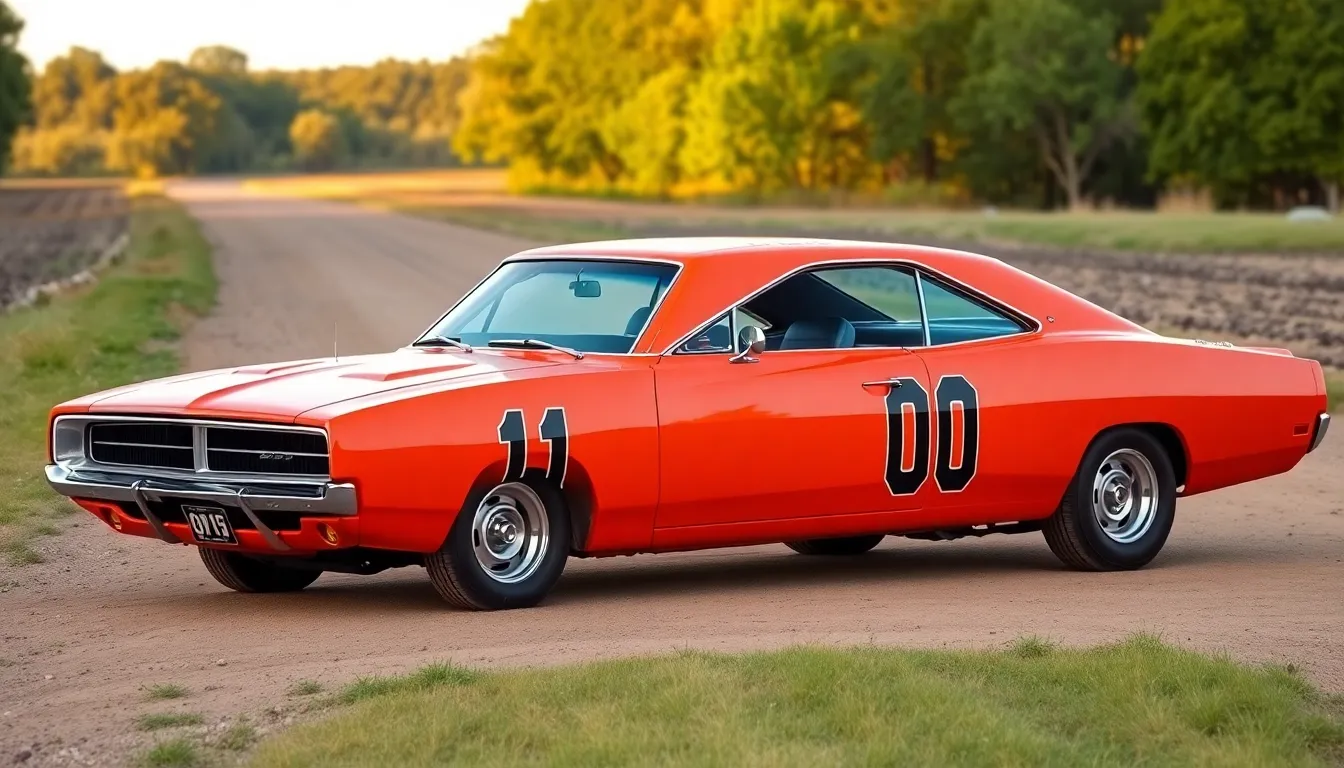We’ve all fallen in love with iconic cars that graced our television screens throughout the decades. From sleek sports cars to rugged muscle machines these four-wheeled co-stars often stole the spotlight and became as memorable as the characters who drove them.
Television’s most famous vehicles have transcended their original shows to become cultural phenomena. Think of KITT from Knight Rider’s talking Trans Am or the General Lee’s orange Charger jumping through Hazzard County. These automotive legends didn’t just transport characters from scene to scene – they captured our imaginations and sparked childhood dreams.
Whether you’re a classic car enthusiast or simply nostalgic for your favorite TV shows we’re diving deep into the most unforgettable television cars that defined generations. From crime-fighting vehicles to family road trip companions these machines represent more than metal and chrome – they’re rolling pieces of entertainment history that continue to influence car culture today.
The General Lee From The Dukes of Hazzard
We witness perhaps the most famous TV car of all time when examining the 1969 Dodge Charger that raced through Hazzard County for seven seasons.
Orange Dodge Charger That Became a Cultural Icon
Orange paint and Confederate imagery made this Dodge Charger instantly recognizable across America during the show’s 1979-1985 run. We see a vehicle that transcended its role as mere transportation to become the third main character alongside Bo and Luke Duke. Racing through dirt roads at breakneck speeds, the General Lee performed stunts that destroyed approximately 300 Dodge Chargers during production.
Distinctive features included the bright orange paint job, “01” racing numbers, and horn that played “Dixie” whenever the Duke boys honked. We observe how these elements created an unforgettable visual and auditory signature that made the car legendary. Jumping over creeks, evading Boss Hogg’s schemes, and sliding around corners became the General Lee’s trademark moves.
Sales of orange Dodge Chargers skyrocketed during the show’s popularity, proving the vehicle’s massive cultural impact. We note that classic car values for 1969 Chargers increased dramatically, with many owners painting their cars orange to match the famous TV version. Muscle car enthusiasts began seeking out similar models, creating a lasting market influence that continues today.
Controversial Confederate Flag and Modern Perspectives
Confederate flag imagery on the car’s roof has sparked ongoing debates about the vehicle’s legacy. We recognize that this symbol, once accepted as part of the show’s Southern charm, now faces scrutiny in contemporary discussions about representation and history. Television networks have pulled reruns, and merchandise featuring the flag has been discontinued by major retailers.
Modern restoration projects often remove or replace the controversial imagery while preserving the car’s other iconic elements. We see collectors and fans grappling with how to honor their nostalgia while acknowledging the symbol’s problematic associations. Some owners display the cars without the flag, focusing instead on the vehicle’s mechanical prowess and stunt capabilities.
Warner Brothers announced plans to produce new General Lee models without Confederate symbols for future projects and licensing deals. We observe how entertainment companies navigate between preserving cultural memories and adapting to evolving social awareness. This shift demonstrates how even beloved TV cars must evolve with changing perspectives while maintaining their core appeal to fans.
KITT From Knight Rider
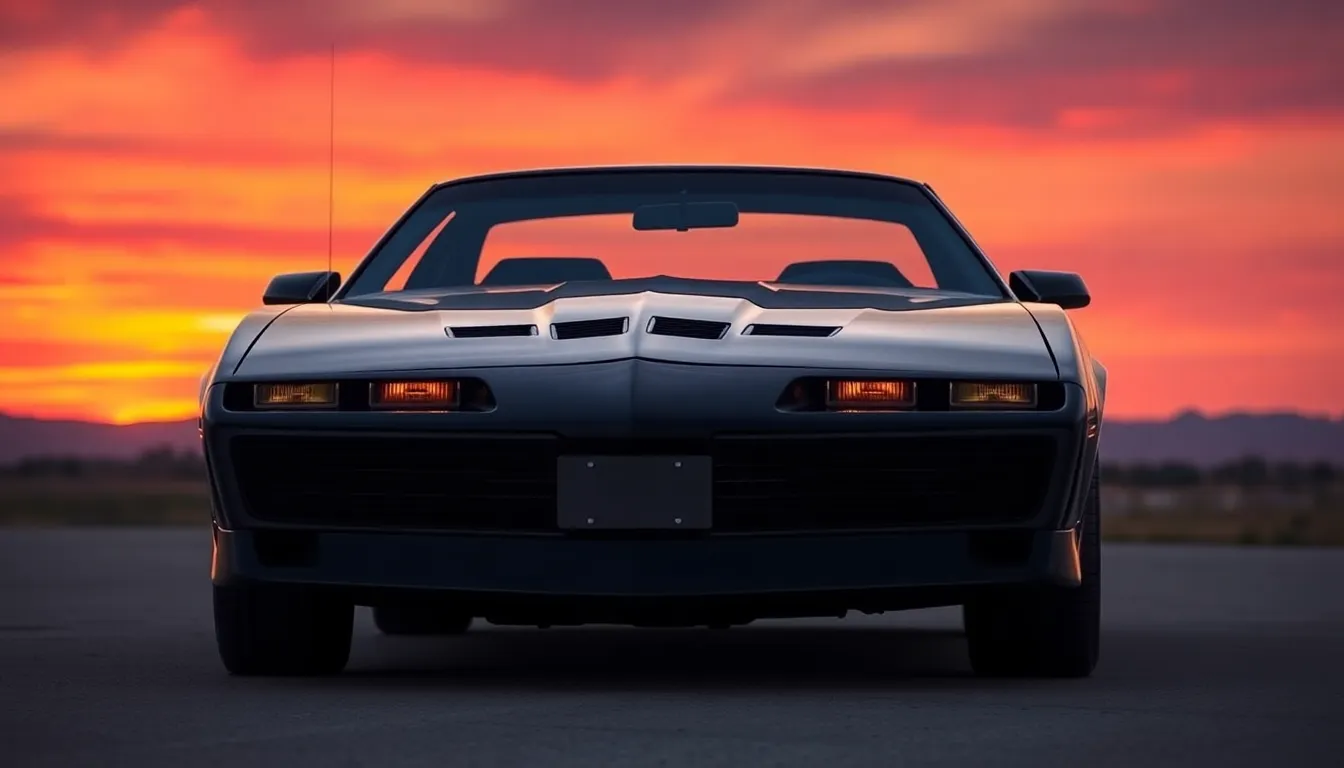
KITT transformed television’s relationship with cars by introducing audiences to an artificially intelligent 1982 Pontiac Trans Am that could think, speak, and protect its driver. We witnessed Michael Knight’s partnership with this remarkable vehicle redefine what entertainment technology could accomplish on screen.
Advanced AI Technology in a Trans Am
KITT’s artificial intelligence system represented cutting-edge technology that captivated viewers from 1982 to 1986. The car’s sophisticated computer brain could analyze situations, make decisions, and communicate with humans using natural language processing capabilities that seemed decades ahead of their time.
Knight Industries designed KITT with molecular bonded shell armor that made the vehicle nearly indestructible against conventional weapons. This advanced protection system allowed the Trans Am to withstand explosions, gunfire, and high-impact collisions while keeping Michael Knight safe during dangerous missions.
The vehicle’s scanner bar swept back and forth across the front grille, creating KITT’s most recognizable visual feature. This red LED light pattern became synonymous with artificial intelligence in popular culture and inspired countless imitators in subsequent television shows and movies.
KITT’s self-driving capabilities amazed audiences decades before autonomous vehicles became reality. The Trans Am could navigate complex routes, parallel park with precision, and even pursue criminals without human input, showcasing futuristic transportation concepts that seemed impossible in the 1980s.
Voice Recognition and Turbo Boost Features
KITT responded to voice commands with remarkable accuracy, understanding Michael Knight’s instructions even during high-stress situations. The car’s voice recognition system processed natural speech patterns and could distinguish between different speakers, ensuring only authorized personnel could access its advanced features.
Turbo Boost became KITT’s signature ability, launching the Trans Am over obstacles, across gaps, and through barriers at incredible speeds. This hydraulic system could propel the vehicle up to 200 feet horizontally and clear heights of 50 feet, creating some of television’s most memorable stunt sequences.
The car’s communication system included a two-way radio, telephone capabilities, and direct links to Knight Industries headquarters. KITT could contact emergency services, coordinate with other agents, and access databases worldwide, making the Trans Am an mobile command center for fighting crime.
KITT’s personality, voiced by William Daniels, gave the car human-like characteristics that viewers connected with emotionally. The AI displayed wit, concern for Michael’s safety, and occasional sarcasm, transforming a vehicle into a beloved character that fans still celebrate today.
The Batmobile From Batman TV Series
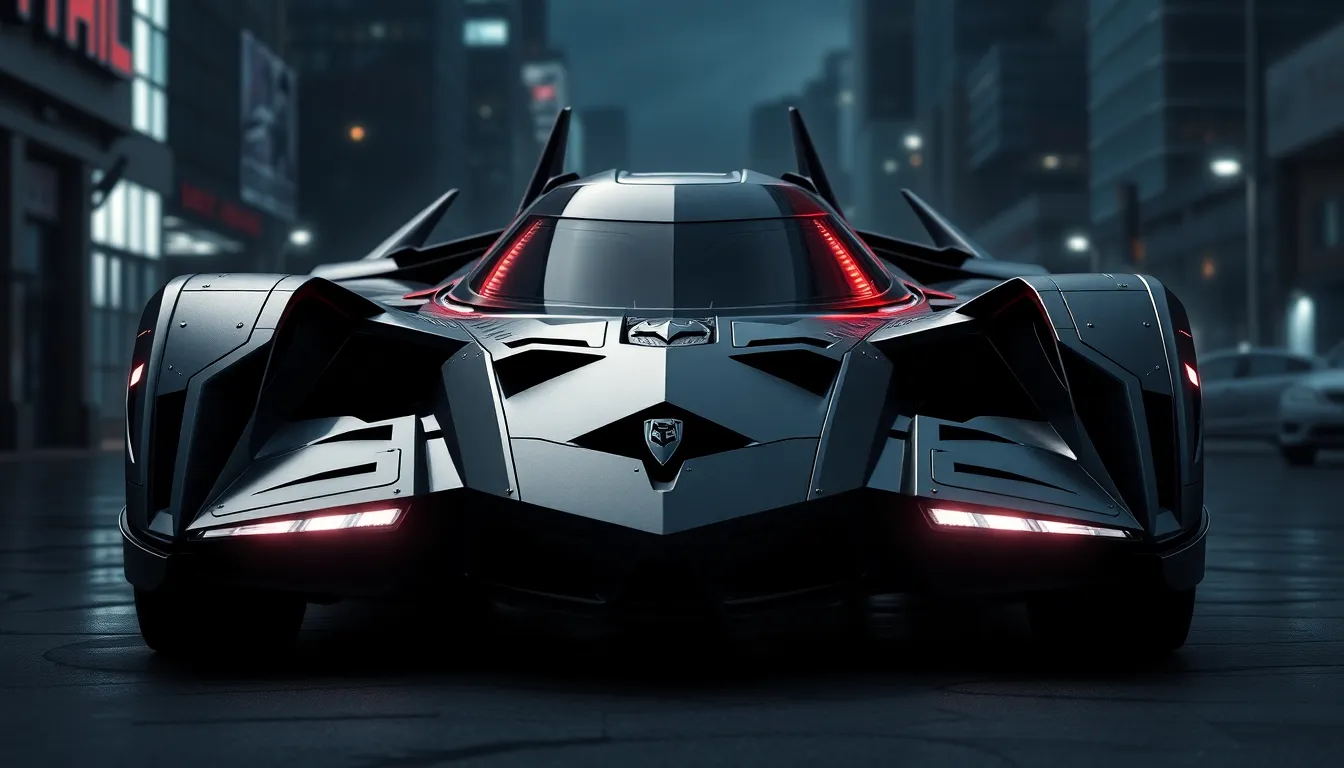
The Batmobile stands as television’s most iconic superhero vehicle, evolving through decades of Batman adaptations to become a symbol of innovation and power. We’ve watched this legendary car transform from campy 1960s charm to the dark, militaristic designs that define modern superhero entertainment.
Evolution From 1960s Camp to Modern Darkness
1960s Batman TV Series introduced us to the original Batmobile, a modified 1955 Lincoln Futura concept car that designer George Barris transformed in just three weeks for $15,000. The bright red pinstripes, atomic batteries, and whimsical gadgets like the Bat Phone perfectly matched the show’s campy tone from 1966 to 1968.
Adam West’s Batmobile featured distinctive flame exhaust, spinning radar dishes, and the famous “Atomic Batteries to Power” starting sequence that became part of pop culture vocabulary. We remember how this version emphasized fun over fear, with bright colors and accessible technology that made Batman feel approachable to family audiences.
1989 Tim Burton Film marked a dramatic shift toward darker aesthetics, influencing how we perceived superhero vehicles in subsequent TV adaptations. Burton’s sleek, jet powered design introduced armor plating and gothic styling that would inspire future television interpretations of the Batmobile.
Modern TV Adaptations have embraced military inspired designs, with shows like “Titans” and “Batwoman” featuring heavily armored vehicles that reflect contemporary concerns about urban warfare. These versions prioritize functionality over flash, incorporating real industry military vehicle elements like reinforced steel plating and tactical lighting systems.
Gadgets and Weapons That Defined Superhero Cars
Defensive Systems in Batman TV series have consistently featured ejector seats, armor plating, and smoke screens that became standard elements across superhero vehicle designs. We’ve seen these features evolve from simple mechanical devices in the 1960s to computer controlled systems in modern adaptations.
Offensive Capabilities include the famous Batmissiles, grappling hooks, and oil slick dispensers that have appeared across different TV versions of the vehicle. The 1960s series introduced non lethal crowd control devices, while recent adaptations have incorporated more aggressive weaponry like electromagnetic pulse generators and riot control systems.
Navigation and Communication Technology evolved from basic radio systems to sophisticated computer networks that connect the Batmobile to the Batcave’s mainframe. Modern TV versions feature GPS tracking, satellite communication, and real time crime analysis systems that process police scanner data automatically.
Stealth and Mobility Features have grown increasingly sophisticated, with early versions using simple camouflage paint while current adaptations employ active camouflage technology and silent running modes. We’ve witnessed the introduction of rocket boosters, retractable wings, and amphibious capabilities that allow the vehicle to operate in multiple environments.
Remote Operation Systems allow Batman to summon and control the Batmobile from distance, a feature that originated in comic books but gained prominence in TV adaptations during the 2000s. These systems include autopilot functions, remote weapons deployment, and emergency extraction protocols that have influenced other superhero vehicle designs across television.
The Mystery Machine From Scooby-Doo
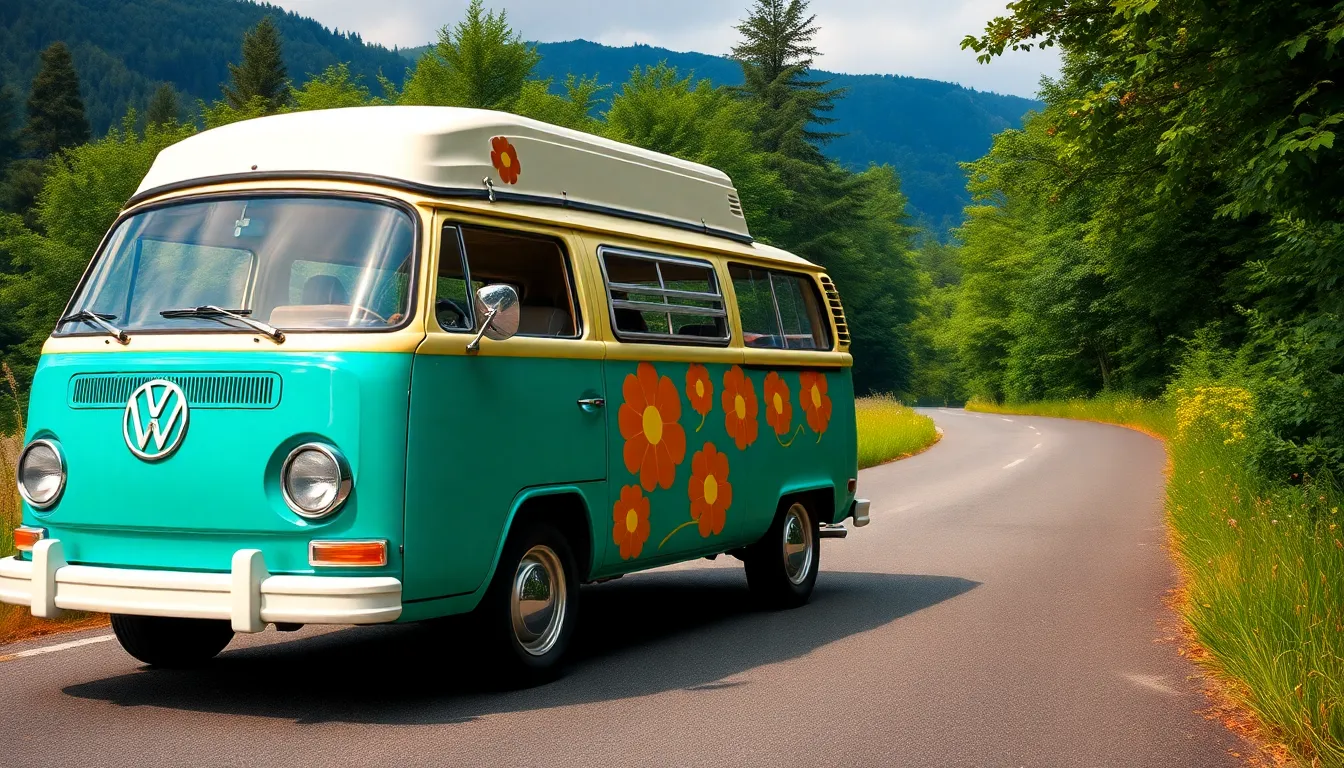
The Mystery Machine stands as one of television’s most recognizable vehicles, transporting Mystery Inc. through countless supernatural adventures since 1969. We’ve watched this colorful van become synonymous with mystery solving and teenage friendship across multiple generations.
Psychedelic Van That Solved Mysteries
Distinctive design made the Mystery Machine instantly memorable with its vibrant teal and green color scheme adorned with orange and yellow flower decals. The van’s psychedelic aesthetic perfectly captured the late 1960s counterculture movement while remaining family friendly for Saturday morning cartoons.
Practical functionality served the gang’s investigative needs with its spacious interior that accommodated five teenagers plus one Great Dane. We see the van’s versatility throughout episodes as it transforms into a mobile headquarters complete with sleeping quarters and equipment storage.
Mechanical reliability became a running joke in the series, with Fred Jones constantly maintaining and repairing the aging Volkswagen Type 2 microbus. The van’s frequent breakdowns often served as plot devices that stranded the gang near mysterious locations.
Cultural significance emerged from the van’s representation of freedom and adventure during America’s hippie era. The Mystery Machine embodied the spirit of road trips and exploration that defined youth culture in the early 1970s.
Impact on Pop Culture and Merchandise
Television influence spawned countless cartoon vehicles that followed the Mystery Machine’s template of colorful, character driven transportation. We observe how shows like “Speed Buggy” and “Jabberjaw” adopted similar anthropomorphic vehicle concepts for their animated series.
Merchandise success generated billions in retail sales through toy replicas, die cast models, and collectible figurines featuring the iconic van. Hot Wheels produced multiple Mystery Machine variations, making it one of their best selling cartoon inspired vehicles since 1971.
Real industry replicas inspired fans to create full scale Mystery Machine reproductions for car shows, conventions, and promotional events. Warner Brothers licensed official Mystery Machine designs for custom van builders, resulting in over 200 documented replicas worldwide.
Modern adaptations continue featuring updated versions of the van in live action films and contemporary animated series. The 2002 “Scooby Doo” movie showcased a modernized Mystery Machine with advanced technology while maintaining its classic appearance and flower power aesthetic.
Herbie From The Love Bug
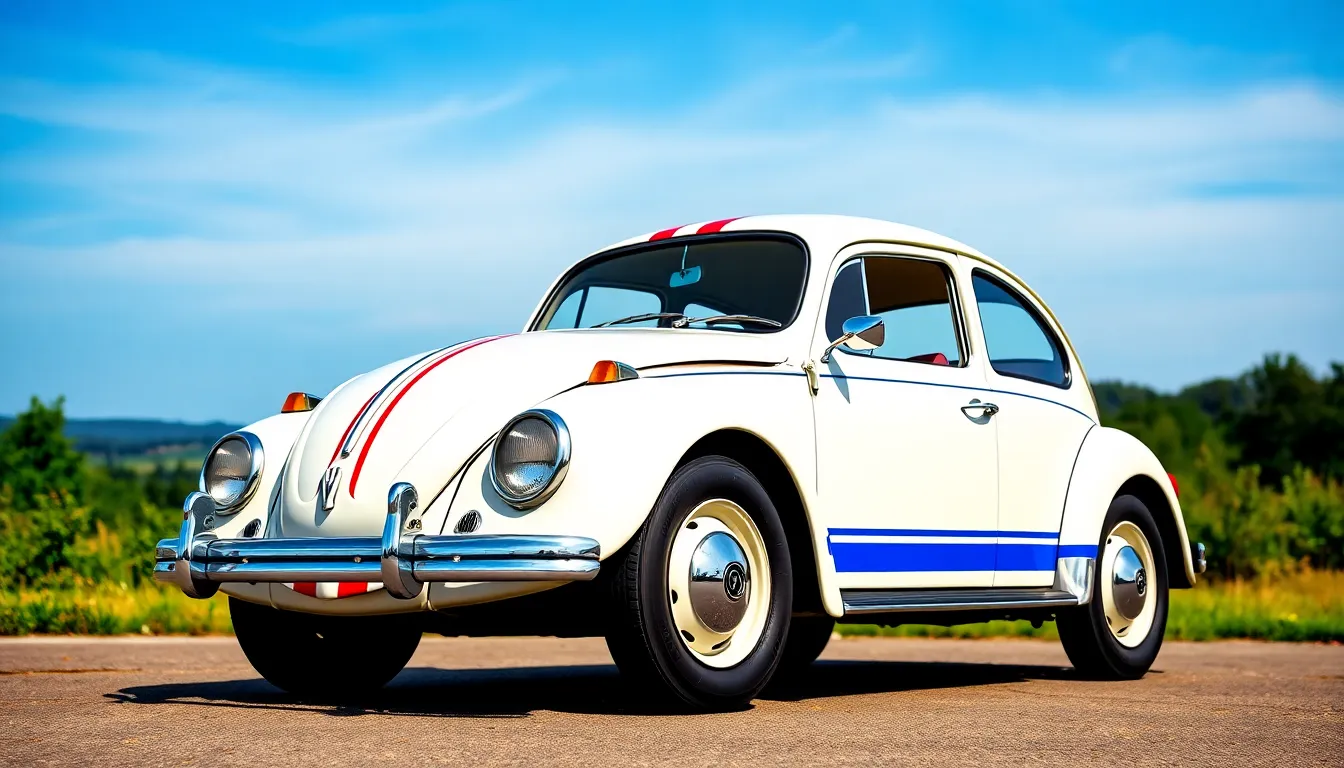
Herbie proves that tv cars don’t always need high tech gadgets or explosive stunts to capture our hearts. This loveable 1963 Volkswagen Beetle showed us that personality and charm could make even the most humble vehicle a superstar.
Volkswagen Beetle With a Mind of Its Own
Herbie stands out as television’s most endearing automotive character because he possessed genuine emotions and free will. The white Beetle with red and blue racing stripes first appeared in Disney’s 1968 film “The Love Bug” before becoming a television fixture through multiple sequels and adaptations. His number 53 became as iconic as any superhero symbol, representing the underdog spirit that resonated with audiences worldwide.
Unlike KITT’s sophisticated AI or the General Lee’s raw power, Herbie’s appeal came from his relatability and mischievous nature. We witnessed him falling in love with other cars, getting jealous of rivals, and even throwing tantrums when upset. The Beetle could drive himself, open his own doors, and communicate through honks and headlight flashes. These simple yet effective methods of expression made him more accessible than high tech alternatives.
Disney’s marketing genius positioned Herbie as the “car with a heart,” emphasizing emotional connection over mechanical superiority. His adventures typically involved helping underdogs win races or solving problems through clever thinking rather than brute force. This approach created a family friendly character that appealed to viewers of all ages without relying on violence or controversy.
Racing Success and Emotional Connection
Herbie’s racing achievements demonstrated that determination could overcome technical disadvantages in competitive motorsports. The little Beetle consistently defeated more powerful vehicles like Porsches, Ferraris, and muscle cars through strategic thinking and pure willpower. We watched him navigate complex race courses, execute perfect timing maneuvers, and inspire his human partners to perform beyond their expectations.
The emotional bond between Herbie and his drivers created storylines that transcended typical car chase entertainment. Jim Douglas, played by Dean Jones in the original films, developed a father son relationship with the Beetle that showed genuine care and mutual respect. Their partnership proved that success came from trust and communication rather than domination or control.
Television adaptations expanded Herbie’s emotional range, showing him experiencing loneliness, friendship, and even romantic feelings toward other vehicles. These storylines helped children understand complex emotions while adults appreciated the clever metaphors for human relationships. The Beetle’s ability to express feelings without speaking made him universally understood across language barriers.
Herbie’s legacy influenced countless automotive characters in animation and live action productions. His success proved that audiences connected with vehicles that displayed genuine personality traits rather than just impressive specifications. Modern car based entertainment still references his emotional approach to character development, showing that authentic connections remain more powerful than flashy technology.
The A-Team Van
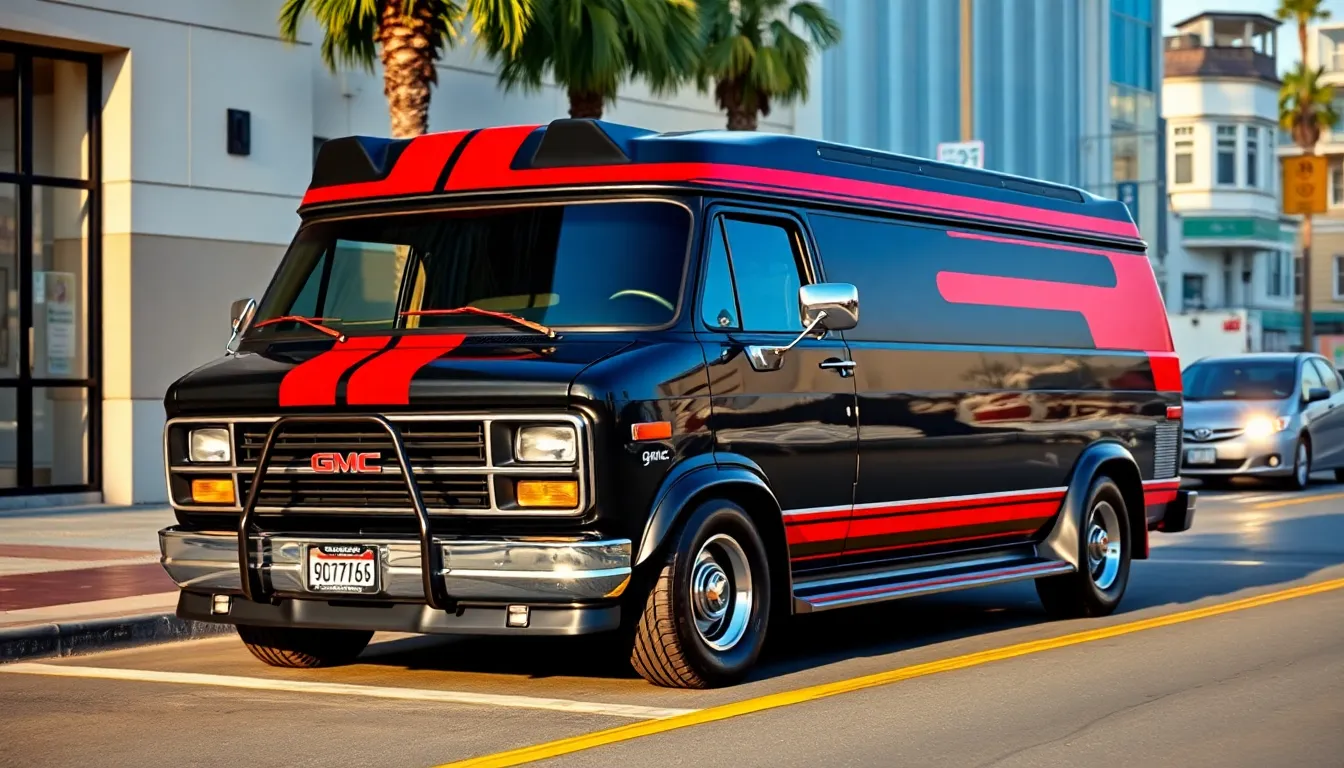
The A-Team’s black GMC Vandura became television’s most recognizable military-style van during its run from 1983 to 1987. This armored vehicle served as both transportation and mobile headquarters for Hannibal Smith’s team of fugitive soldiers turned mercenaries.
Black GMC Vandura With Red Stripe
The 1983 GMC Vandura G-15 featured a distinctive black paint job with bold red racing stripes that ran across the hood and sides. Its menacing appearance perfectly matched the team’s covert operations and military backgrounds. The van’s factory specifications included a 5.7-liter V8 engine that provided enough power for high-speed chases through Los Angeles streets.
Production teams used multiple identical vans during filming to handle the demanding stunt sequences. Each vehicle received modifications like reinforced bumpers and roll cages to protect stunt drivers during crashes. The show’s creators chose the GMC Vandura over other van models because of its spacious interior and robust construction that could withstand repeated impacts.
Mobile Command Center for the Fugitive Heroes
Inside the van, B.A. Baracus transformed the cargo area into a sophisticated command center equipped with communication equipment and surveillance gear. The interior featured custom-built workbenches where the team fabricated weapons and modified existing equipment for their missions. Multiple television monitors displayed maps and intelligence gathered during reconnaissance operations.
Storage compartments lined the van’s walls to hold the team’s extensive arsenal of weapons and demolition supplies. The vehicle’s electrical system supported advanced radio equipment that allowed the team to monitor police frequencies and coordinate with their clients. Custom seating arrangements provided space for all four team members during extended missions across the country.
The van’s mobility gave the A-Team a important tactical advantage over their enemies who relied on fixed locations. Face could conduct his con games from the van while Murdock piloted stolen aircraft to support ground operations. This mobile headquarters concept influenced countless action shows that followed, establishing the armored van as a staple of 1980s television adventure series.
Magnum P.I.’s Ferrari 308 GTS
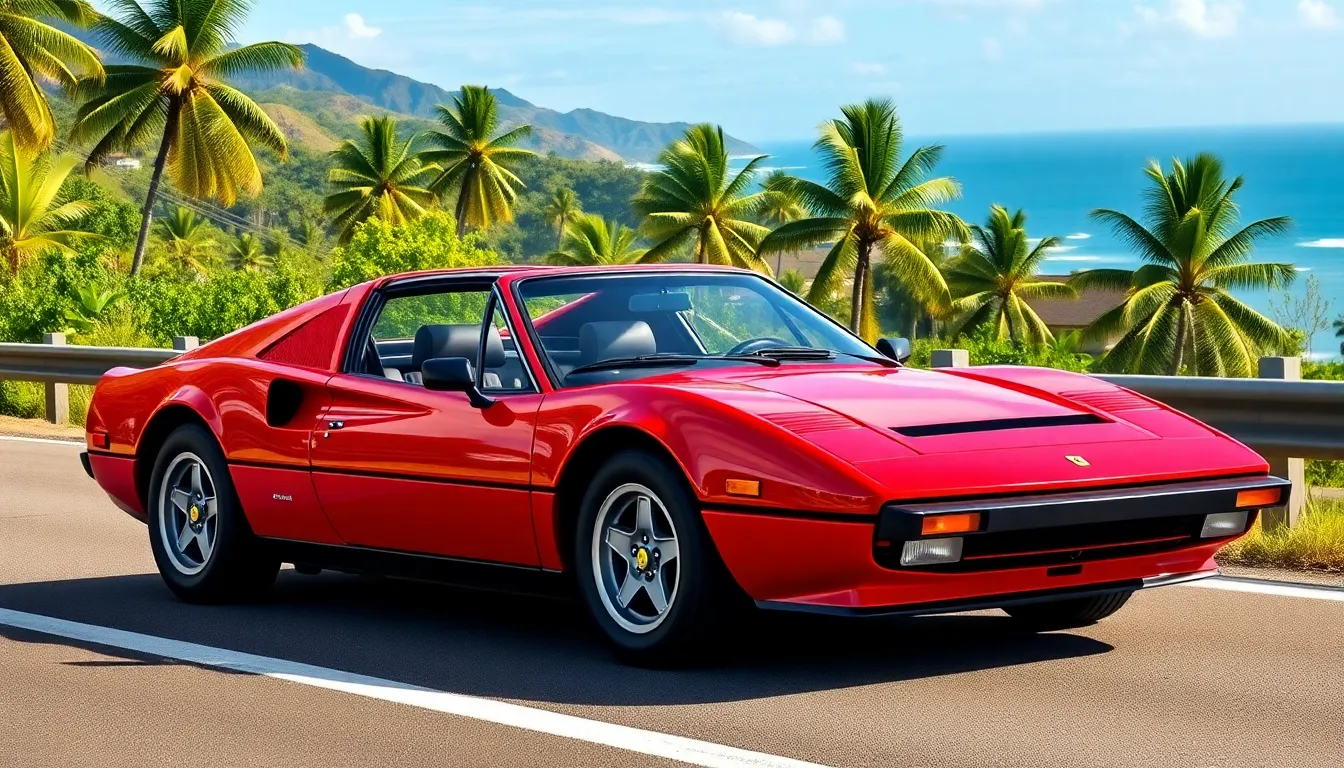
Thomas Magnum’s Ferrari 308 GTS became television’s most coveted sports car when it roared across our screens from 1980 to 1988. This Italian masterpiece transformed Hawaii’s scenic highways into the ultimate playground for television’s coolest private investigator.
Red Sports Car That Defined 1980s Cool
Ferrari’s 308 GTS captured the essence of 1980s luxury with its stunning Rosso Corsa red paint and removable targa top. We watched as this mid-engine V8 sports car delivered 240 horsepower through its distinctive exhaust note that echoed across Oahu’s coastline. The car’s sleek Pininfarina design featured pop-up headlights and side air intakes that made every entrance memorable.
Tom Selleck’s character drove the Ferrari with casual confidence that epitomized the decade’s aspirational lifestyle. Viewers connected with Magnum’s relationship to the car as a symbol of success borrowed from his wealthy benefactor Robin Masters. The 308 GTS became so synonymous with the show that Ferrari sales in the United States increased by 35% during the series’ peak years.
Production teams used multiple Ferrari 308 models throughout filming to accommodate Hawaii’s challenging shooting conditions. Saltwater exposure and tropical humidity required constant maintenance that added authenticity to Magnum’s occasional mechanical troubles. These real-industry challenges created memorable episodes where the Ferrari’s temperamental nature became part of the storyline.
Hawaiian Paradise and Detective Work
Hawaii’s tropical setting provided the perfect backdrop for the Ferrari 308 GTS to showcase its performance capabilities. We witnessed countless chase scenes winding through Diamond Head’s crater roads and along the North Shore’s coastal highways. The car’s handling characteristics suited the island’s varied terrain from urban Honolulu streets to rural plantation roads.
Magnum’s detective work often required quick escapes where the Ferrari’s acceleration proved essential to the plot. The V8 engine could propel the lightweight sports car from zero to sixty mph in 6.5 seconds, making it ideal for television’s action sequences. Camera crews capitalized on the car’s photogenic qualities by filming it against Hawaii’s stunning natural landscapes.
The Ferrari served as both transportation and status symbol that opened doors during Magnum’s investigations. Wealthy suspects and informants often responded differently to someone arriving in an exotic Italian sports car versus a typical detective’s sedan. This ever-changing added layers to character interactions while highlighting the contrast between Magnum’s humble background and his borrowed luxury lifestyle.
Modern car enthusiasts continue to seek out 1980s Ferrari 308 models specifically because of their connection to Magnum P.I. Original red examples with targa tops command premium prices at auctions, with some selling for over $150,000. The show’s lasting influence proves how effectively the Ferrari 308 GTS captured our imagination as the ultimate symbol of tropical sophistication and automotive excellence.
Starsky and Hutch’s Ford Gran Torino
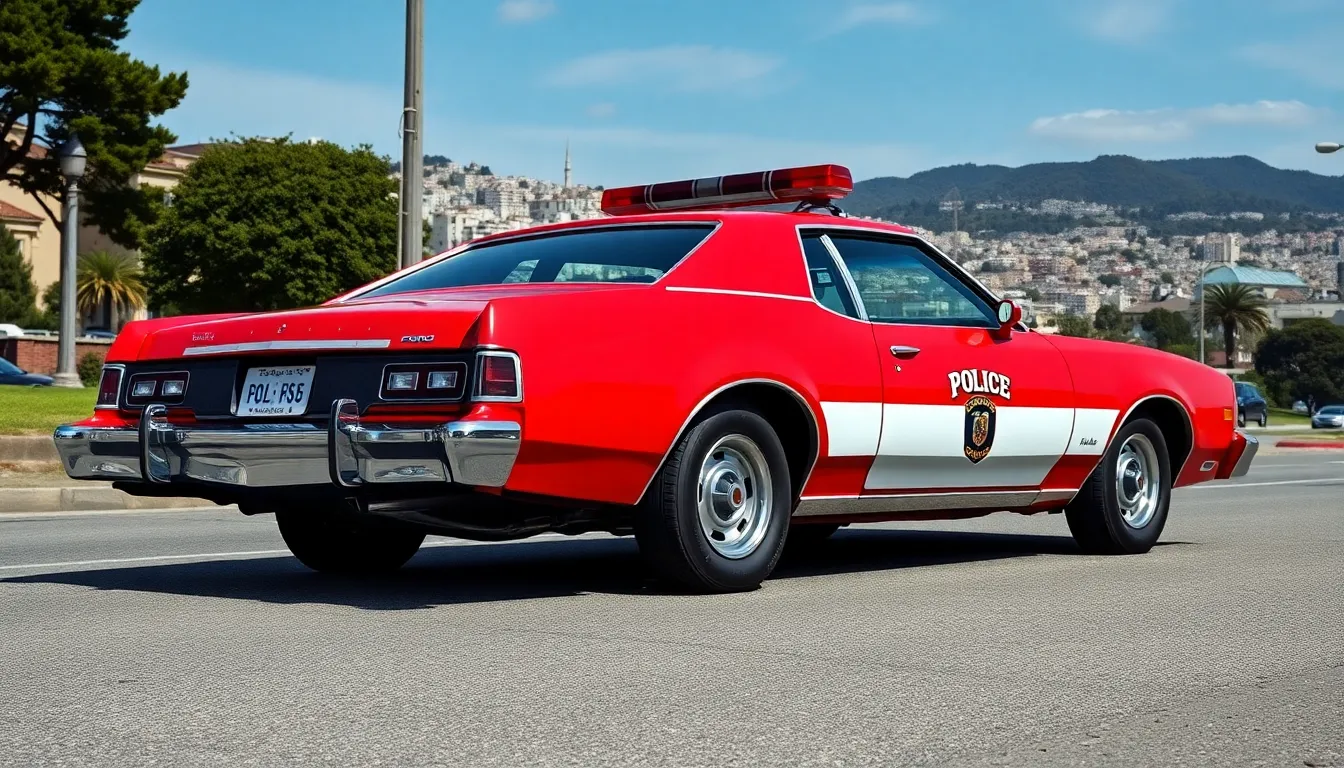
The 1975 Ford Gran Torino dominated television screens from 1975 to 1979, becoming one of the most recognizable police cars in entertainment history. This American muscle car transformed street cop dramas and established a new standard for action vehicle sequences.
Red and White Striped Police Car
Distinctive paint schemes made the Gran Torino instantly recognizable across America’s television industry. The bright red body featured a dramatic white racing stripe that curved along the sides, creating a visual signature that viewers could spot from blocks away. Bold lettering spelled out “STARSKY & HUTCH” across the doors, while the California license plate “537 OKG” became as famous as the characters themselves.
Authentic police modifications enhanced the car’s credibility as an undercover vehicle. Chrome push bars mounted on the front bumper suggested serious pursuit capabilities, while a removable red beacon light could transform the Gran Torino from civilian transport to emergency responder in seconds. Powerful V8 engine options gave the car legitimate performance credentials that matched its aggressive appearance.
Cultural impact extended far beyond the television screen as Ford dealers reported increased Gran Torino sales during the show’s peak years. Enthusiasts began customizing their own vehicles with similar paint schemes, creating a nationwide tribute to the iconic police car. Lasting influence continues today through classic car shows and collector auctions where authentic Starsky and Hutch replicas command premium prices.
Chase Scenes That Thrilled Audiences
High-speed pursuits through San Francisco’s steep streets showcased the Gran Torino’s impressive handling capabilities. The car’s heavy suspension allowed it to absorb massive jumps while maintaining control during tight cornering sequences. Dramatic stunts included flying over hills, sliding through narrow alleyways, and executing precision 180-degree turns that became the show’s trademark.
Professional stunt coordinators used multiple Gran Torinos during filming to ensure continuous action sequences. Each episode typically destroyed at least one vehicle through crashes, explosions, or mechanical failures from extreme driving conditions. Realistic sound effects captured the car’s throaty exhaust note and screeching tires, adding authenticity to every chase scene.
Technical innovations included mounting cameras directly on the Gran Torino to capture driver perspectives during high-speed sequences. This approach created an immersive viewing experience that placed audiences directly inside the action. Revolutionary filming techniques influenced countless police shows that followed, establishing the template for modern television car chases.
Memorable episodes featured the Gran Torino pursuing everything from motorcycles to helicopters across diverse California landscapes. The car’s versatility allowed it to perform equally well in urban environments and desert settings. Enduring popularity of these chase sequences continues to inspire modern action directors who study the show’s kinetic energy and practical stunt work.
The Flintstones’ Foot-Powered Car
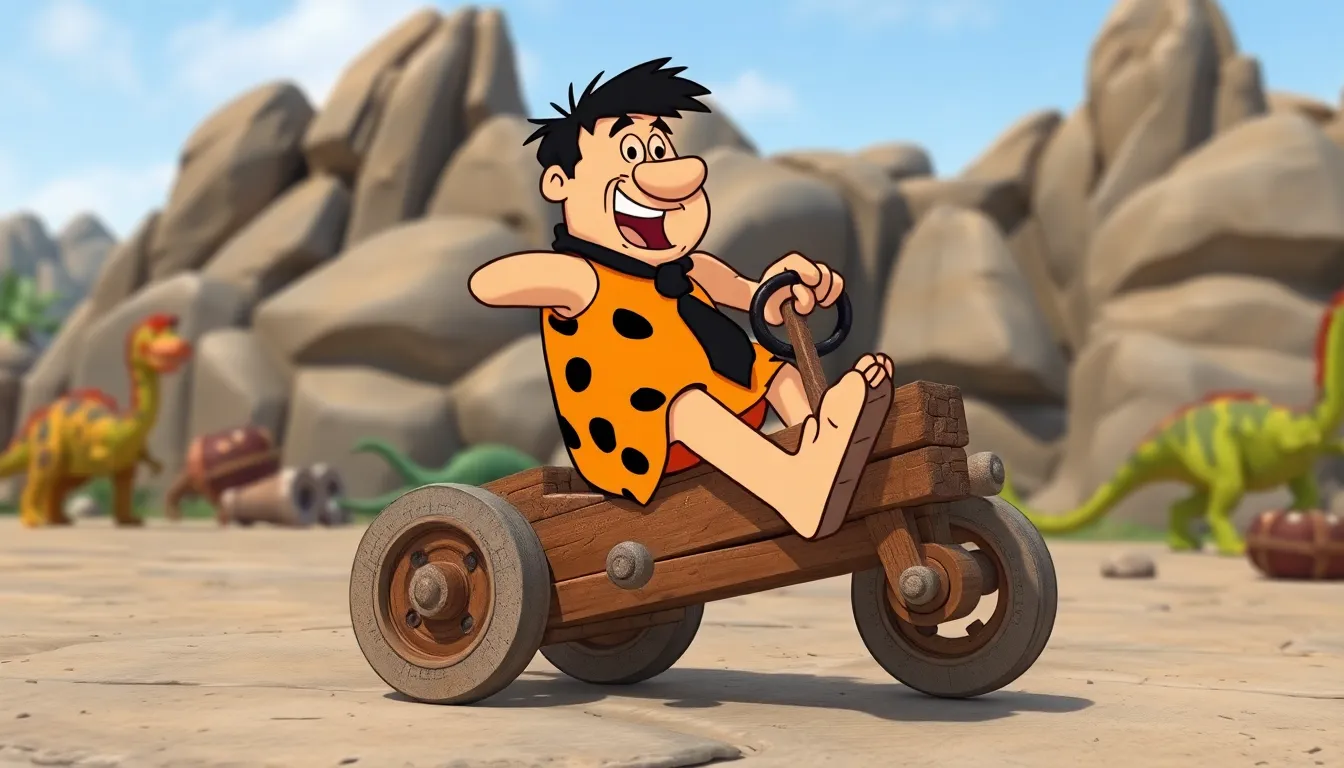
The Flintstones introduced television audiences to the industry’s most primitive yet charming vehicle in 1960. We witnessed Fred Flintstone’s stone-age sedan become an instant classic that would influence animated transportation for decades.
Stone Age Transportation Comedy
Physical comedy reached new heights when Fred and Barney powered their car with pure foot strength. We watched countless episodes where the duo’s running legs created dust clouds beneath their prehistoric vehicle, establishing a visual gag that became synonymous with The Flintstones brand. Stone wheels, wooden logs for axles, and animal hide upholstery transformed this foot-powered contraption into television’s most memorable caveman creation.
Comedy writers crafted elaborate chase scenes showcasing the car’s unique propulsion system. We observed Fred’s frantic leg movements during high-speed pursuits with dinosaurs or rival bowling teams, while passengers bounced helplessly in wooden seats. The vehicle’s braking system relied entirely on Fred’s feet dragging against the ground, creating sparks and leaving cartoon-style skid marks across Bedrock’s rocky terrain.
Mechanical failures provided endless entertainment opportunities for the show’s writers. We witnessed wheels falling off during crucial moments, forcing the Flintstone family to hop awkwardly toward their destination. The car’s primitive construction meant constant repairs using stone tools and dinosaur assistance, turning every transportation scene into a potential comedy goldmine.
Environmental Message Before Its Time
Zero-emission transportation appeared on television screens decades before environmental awareness became mainstream. We recognize The Flintstones’ foot-powered car as an early example of sustainable mobility, producing no pollution while requiring only human energy for operation. This prehistoric vehicle demonstrated how families could travel without harming their Stone Age environment.
Renewable resources defined every aspect of the car’s construction and operation. We observed how Fred’s vehicle utilized locally sourced materials like granite, wood, and animal products, creating a completely biodegradable transportation solution. The manufacturing process involved no industrial pollution, fossil fuels, or synthetic materials that would harm Bedrock’s pristine network.
Modern viewers increasingly appreciate the show’s unintentional environmental messaging through Fred’s car design. We’ve witnessed growing interest in human-powered vehicles and sustainable transportation options that mirror the Flintstones’ approach to mobility. Contemporary bicycle enthusiasts and eco-conscious consumers often reference the foot-powered car as inspiration for reducing their carbon footprint while maintaining personal transportation freedom.
Speed Racer’s Mach 5
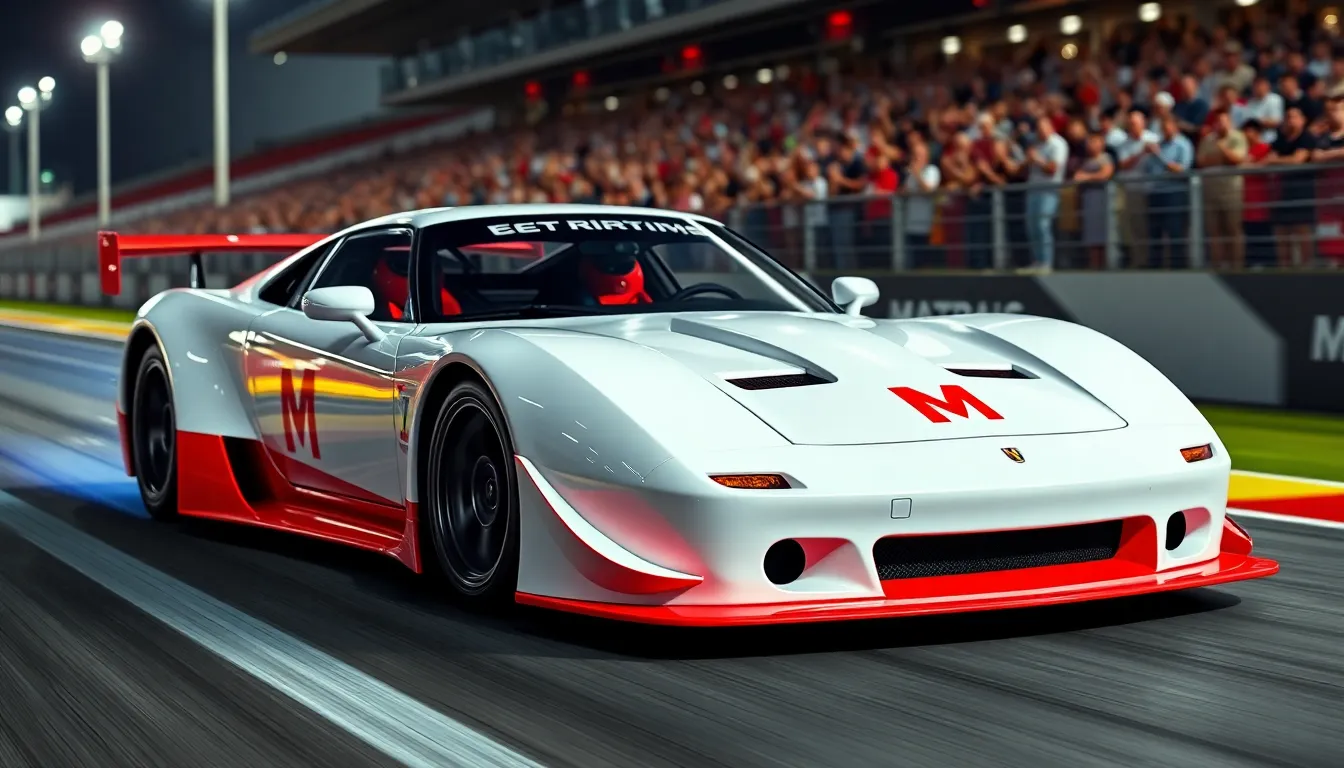
The Mach 5 brought anime-inspired automotive innovation to television screens worldwide, showcasing futuristic racing technology that captivated audiences from 1967 to 1968. This white racing machine established the template for high-tech cartoon vehicles that followed in entertainment history.
Anime Racing Car With Special Features
Speed Racer’s Mach 5 introduced television viewers to cutting-edge racing technology that seemed impossible in the 1960s. The car’s aerodynamic white body featured distinctive red trim and the iconic “M” logo that became synonymous with futuristic racing design. Advanced suspension systems allowed the vehicle to navigate treacherous mountain roads and desert terrain with remarkable stability.
Bulletproof construction protected Speed from enemy attacks during dangerous missions across various landscapes. The Mach 5’s powerful engine delivered incredible acceleration that could outpace conventional racing cars of its era. Reinforced tires provided exceptional grip on surfaces ranging from ice to volcanic rock.
Special cameras mounted throughout the vehicle transmitted real-time footage to Speed’s family and racing team. Communication systems enabled constant contact with Pops Racer and other support crew members during high-stakes competitions. These technological features established the Mach 5 as television’s first truly intelligent racing machine.
Buttons and Gadgets for Every Situation
Seven steering wheel buttons controlled the Mach 5’s most impressive capabilities, each designed for exact racing and survival scenarios. Button A activated powerful jacks that lifted the car above obstacles or enabled quick tire changes during competitions. Button B extended cutting blades that could slice through barriers or clear debris from racing paths.
Button C provided periscope functionality for underwater navigation when Speed encountered flooded race courses. Button D activated deflector shields that protected against projectiles and environmental hazards. Button E illuminated powerful night vision headlights for racing in darkness or fog conditions.
Button F released homing pigeons for emergency communication when radio systems failed in remote locations. Button G deployed underwater breathing apparatus that allowed the Mach 5 to function as a submarine during aquatic sequences. These innovative controls influenced countless animated vehicles that followed, establishing the template for gadget-equipped racing cars in entertainment media.
Modern racing enthusiasts continue celebrating the Mach 5’s technological legacy through replica builds and tribute vehicles at car shows worldwide.
Conclusion
These legendary TV cars have transcended their original shows to become permanent fixtures in our collective automotive consciousness. From KITT’s artificial intelligence to the General Lee’s rebellious spirit each vehicle represents a unique chapter in television history that continues to influence car culture today.
We’ve witnessed how these four-wheeled co-stars shaped our childhood dreams and adult aspirations. Whether it’s the Mystery Machine’s psychedelic charm or the Mach 5’s futuristic technology these vehicles prove that sometimes the most memorable characters don’t even have lines.
Their legacy lives on through car shows classic auctions and the countless enthusiasts who still modify their rides to honor these iconic machines. These TV cars didn’t just transport characters—they transported us into worlds where anything was possible.
Frequently Asked Questions
What made KITT from Knight Rider so special compared to other TV cars?
KITT was groundbreaking as television’s first artificially intelligent car with advanced features like natural language processing, self-driving capabilities, and voice recognition. The 1982 Pontiac Trans Am could communicate with its driver Michael Knight and had a memorable personality voiced by William Daniels, making it more than just a vehicle but a beloved character that captivated audiences from 1982 to 1986.
Why is the General Lee from The Dukes of Hazzard controversial today?
The General Lee, a 1969 Dodge Charger, became controversial due to the Confederate flag on its roof. While originally seen as part of the show’s Southern charm during its 1979-1985 run, the symbol now faces scrutiny in modern times. This has led to flag removal from restoration projects, discontinued merchandise, and Warner Brothers planning new models without Confederate symbols.
How did the Batmobile evolve throughout different Batman adaptations?
The Batmobile transformed from the campy 1960s version (a modified 1955 Lincoln Futura with bright colors and whimsical gadgets) to darker, military-inspired designs following Tim Burton’s 1989 film. Modern versions feature sophisticated technology including remote operation systems and advanced navigation, reflecting changing societal concerns and technological advancements in superhero storytelling.
What makes the Mystery Machine from Scooby-Doo culturally significant?
Since 1969, the Mystery Machine has symbolized mystery-solving and teenage friendship with its distinctive psychedelic design capturing late 1960s counterculture. The van represents freedom and adventure, embodying America’s hippie era road trip spirit. Its cultural impact has inspired countless cartoon vehicles and generated billions in merchandise sales, maintaining relevance through modern adaptations.
How did Herbie differ from other famous TV cars?
Unlike high-tech vehicles like KITT or powerful cars like the General Lee, Herbie’s appeal came from personality and charm rather than gadgets or stunts. The 1963 Volkswagen Beetle displayed genuine emotions and free will, proving that determination could triumph over technical advantages and showing audiences connect more with vehicles displaying authentic personality traits.
What impact did Magnum P.I.’s Ferrari have on car sales?
The Ferrari 308 GTS became television’s most coveted sports car from 1980-1988, with its Rosso Corsa red paint and removable targa top epitomizing 1980s luxury. The show’s association with the Ferrari led to a significant increase in U.S. Ferrari sales during peak years, as the car symbolized success and sophistication to viewers.
Why was the A-Team Van so recognizable?
The black GMC Vandura (1983-1987) became television’s most recognizable military-style van due to its distinctive black paint with bold red racing stripes. Serving as both transportation and mobile headquarters, it was equipped with communication and surveillance gear, influencing countless action shows and establishing the armored van as a 1980s television staple.
How many General Lee cars were destroyed during filming?
Approximately 300 Dodge Chargers were destroyed during The Dukes of Hazzard production due to the show’s demanding stunt sequences. The car’s popularity led to increased sales and lasting influence on classic car values, with many owners painting their vehicles orange to emulate the iconic “01” racing design.

